- As a leader in sea logistics, Kuehne+Nagel closely tracks and collects data on the movement of vessels, including actual arrivals and vessel delays.
- A summary of this analysis, based on neutral data, is published monthly in our Schedule Reliability Report, available on Sea News.
Executive Summary
Global schedule reliability declined slightly to 55.2% in July, marking a 2.4 percentage point drop compared to June.
Despite this month-on-month decrease, July’s performance significantly exceeded that of the same period last year, when it stood at 47.3%.
The average arrival delay of LATE vessels remained steady at around 3.9 days, indicating that late vessels were not significantly delayed compared to the previous month.
The average arrival delay across ALL vessels was 1.6 days, suggesting that overall delays have stabilised even though reliability fluctuated.
Similarly, several trades suffered a setback in July, including Asia↔North Europe and Asia↔Mediterranean/Black Sea.
The Mediterranean/Black Sea↔South America and North Europe↔South America recorded strong gains last month but were not able to counter the declines in other trades.
Blank sailing data (weeks 27-31) recorded seven void sailings on Asia→North Europe, accounting for 8.8% of total capacity.
On Asia→North America, carriers announced 17 blanked sailings, accounting for 4.8% of total capacity, with 7 to the East Coast and 10 to the West Coast.
Global On-Time Performance
July’s global on-time performance receded slightly to 55.2%, a 2.4 percentage point drop compared to June.
As indicated below, 2022 and 2024 followed a similar fluctuation, reinforcing a broader trend of mid-year improvements in schedule reliability followed by fluctuations in the second half of the year.
Notably, July 2025’s reliability remains well above the levels recorded in July 2024 (46.0%), which may indicate sustained recovery.
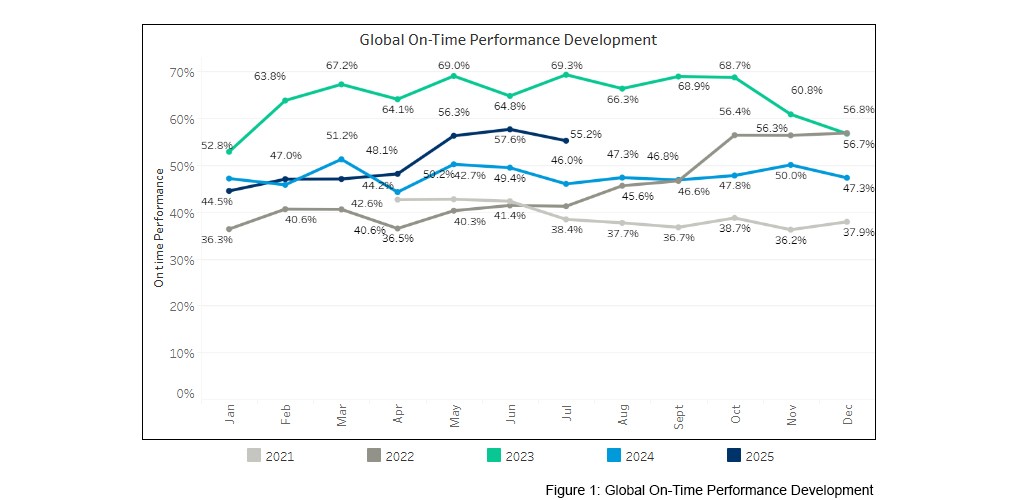
LATE vessels arrived on average 3.9 days behind schedule; a slight improvement compared to the previous month.
This indicates that while fewer vessels arrived on time, those that were delayed did not experience significantly longer disruptions.
The figure below shows, July’s average delay has dipped below that of 2024 for the first time this year.
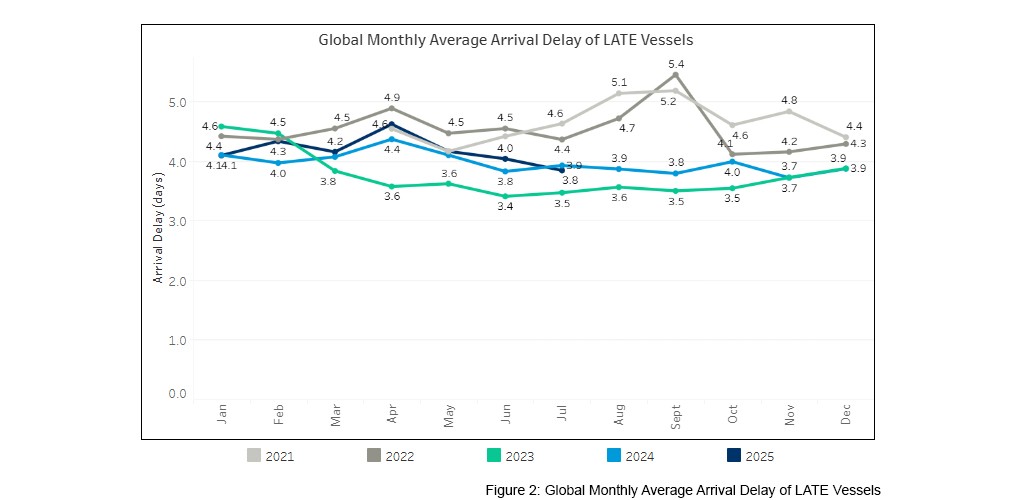
The average arrival delay for ALL vessels remained stable at 1.6 days.
As indicated below, the average delays in 2025 followed a similar trend to that of previous years: a peak in April, and stability in the following months.
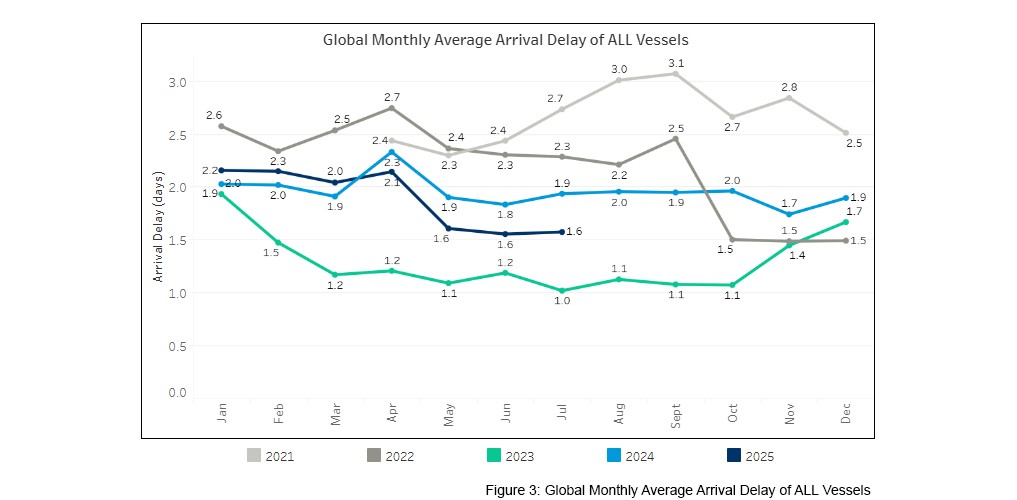
Reliability per Trade Lane
Performance across the 11 major trades ranged from 46.2% to 88.0% in July.
Some of the largest trades contributed to the overall drop in reliability.
The Asia↔Mediterranean/Black Sea and Asia↔North Europe lanes experienced the sharpest month-on-month declines, dropping by 15.8 and 13.3 percentage points, respectively.
Despite these setbacks, both lanes still showed modest year-on-year improvements, indicating a longer-term recovery.

The North America↔South America lane was the most reliable, at 88.0%, up 31.6 percentage points from the previous year.
North Europe↔South America and Mediterranean/Black Sea↔South America performed strongly, supported by consistent gains throughout the year.
Overall, while some lanes saw short-term volatility, most improved their schedule reliability in the first half of the year when compared to 2024.
Reliability on North Europe↔South America
South America→North Europe
As shown in the table above, North Europe↔South America showed steady improvement in 2025.
A closer look at the headhaul direction reveals that reliability started off at an all-time low in January and continued to improve month over month.
In July, a steep increase of 12.3 percentage points pushed reliability over 75%, surpassing last July by 17.8 percentage points.
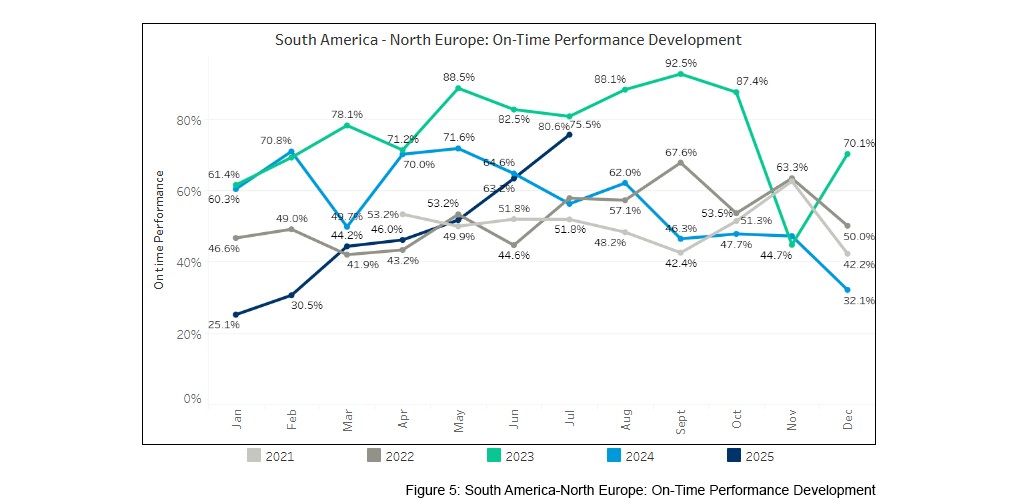
Correspondingly, the average delay of ALL vessels improved consistently from a high of 3.5 days in January to 0.6 days in July.
Although the average arrival delay of LATE vessels fluctuated through the first half of the year; there was an overall improvement from 4.8 days at the start of the year to 3.1 days in July.
North Europe→South America
The backhaul leg recorded an overall improvement in reliability for the first half of the year and continued to improve in July.
July’s reliability on this leg was 81.4%, a gain of 3.9 percentage points month-on-month.
Similar to the headhaul leg, this performance strongly contrasts with that of July 2024, when reliability was 66.1%.
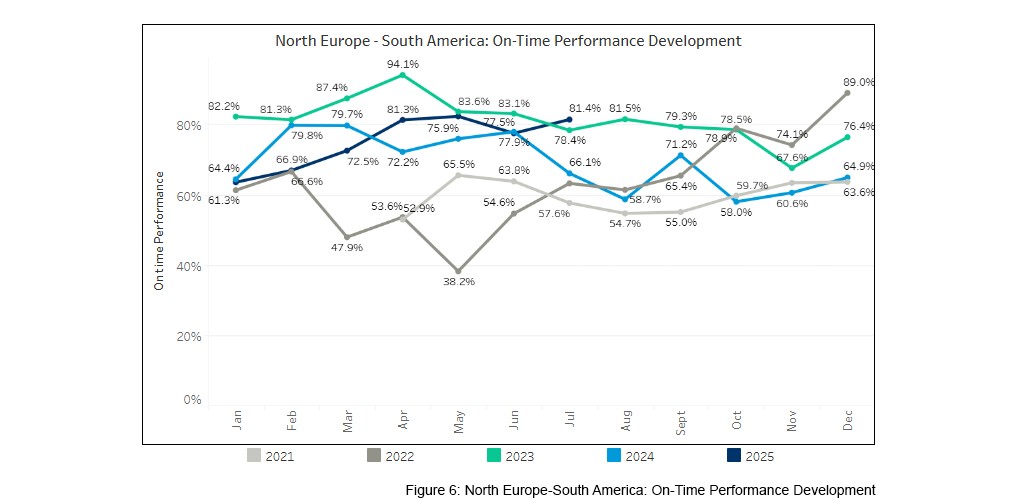
The average delay of LATE vessels improved from 4.4 days to 3.3 days in June, before increasing slightly to 3.7 days in July.
For ALL vessels, the average delay was 0.4 days last month.
Methodology
Calculating the on-time performance
To calculate the on-time performance of a service, Kuehne+Nagel uses vessel schedules from carrier(s) offering that service. Only carrier schedules that match our quality criteria are used for the schedule reliability calculation.
As carriers update schedules constantly, they become more accurate the closer vessels get to a destination port. For this reason, we have implemented a "schedule freeze period" of 14 days prior to actual vessel arrival. In other words, we benchmark the actual arrival with what carriers last announced 14 days earlier. To identify the actual time of arrival, Kuehne+Nagel consumes AIS (Automatic Identification System) vessel data. All vessels which arrive within a +/- 24-hour window at the port of destination compared to the last announced arrival are considered to be on time. Port call omissions and blank sailings announced after the 14-day freeze are excluded from the calculation.
Assigning carrier services to multiple trade lanes
Many services operate on various trade lanes (e.g. a carrier service between Asia and North Europe also calls ports in the Middle East and or the Mediterranean), and therefore carrier services may be listed in multiple trade lanes.
Definition of trade lanes
There is no common standard for the definition of trade lanes. This means, depending on the source, you will find different trade lanes as well as different regions, countries and ports assigned to a trade lane. Kuehne+Nagel has defined its own way of mapping and has assigned ports to these trade lanes accordingly. On-time performances of vessels are captured in our reports on defined main trades, meaning trades moving large container volumes on vessels. Therefore, niche trades and services within one trade, called "Intra Trade" services (e.g. Intra-Asia, Intra-Europe), are currently out of scope.
A PDF version of this report can be found here.







